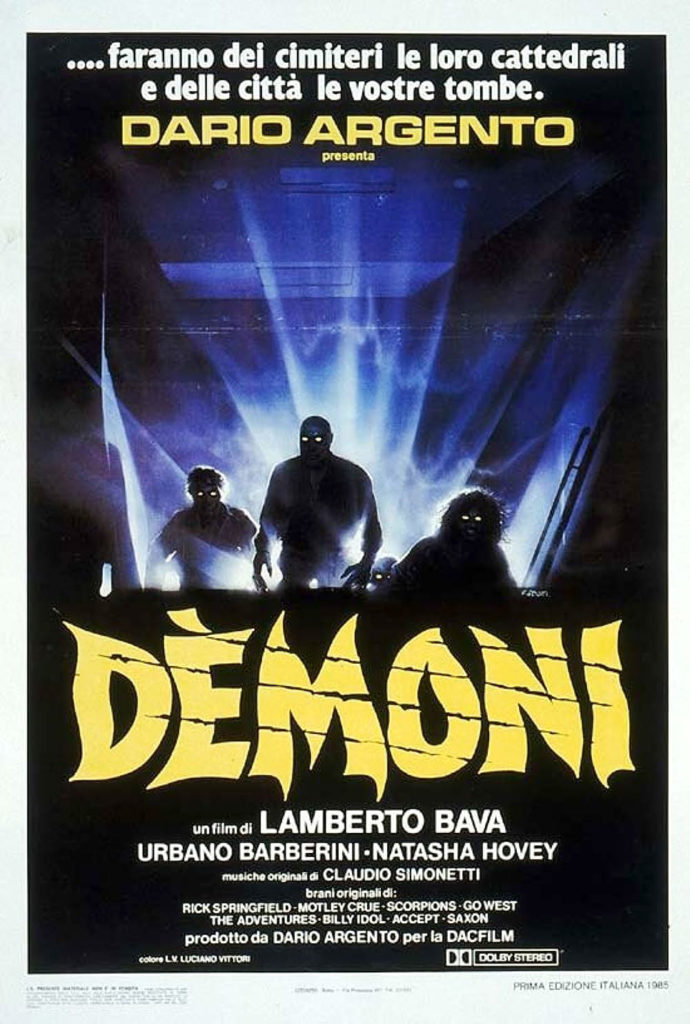I praised Lucio Fulci for his storytelling in Manhattan Baby. But, truth be told, I wouldn’t mind it at all if every film I watched for The Italian Horrorshow were as wild and unhinged as Lamberto Bava’s Demons, from 1985. Bava proved with his film that it isn’t necessary to have a complex, or even coherent, plot for a horror flick to be a success. In fact, this jumble of sensory overload is one of the most enjoyable films I’ve seen from one of horror’s golden ages.
From a screenplay that passed through many hands, including producer Dario Argento’s, Demons follows a quite large ensemble cast as they try to survive a zombie apocalypse. That’s right. Despite the title, Demons spends much of its time navigating the genre rules of zombies, rather than demonic possession. The baddies in this film are never referred to as ‘zombies,’ while calling them ‘demons’ is de rigueur. But, Bava’s heavy reliance on zombie tropes does beg the question: is this a zombie flick? The internet has differing opinions on that, and since I maintain this site as my own contribution to the noise, I feel it my duty to share my thoughts. Yes, this is a zombie flick. No horror film can hew so closely to those established tropes while pretending to be something else. I’m not saying that Bava and company are guilty of misdirection. Rather, they were just trying to keep things fresh, by wrapping the familiar in something a little different. Nothing wrong with that, especially when it’s done well.
The characters in Demons all have their own little plotlines, but those melt away at the end of the first act, when things get going. That’s good, because keeping track of every major cast member is an impossible task. It’s much easier to just think of everyone as fodder. So, what’s the deal with the fodder?
In Berlin, a mysterious masked man (Michele Soavi) is handing out free passes to a movie screening. Thinking it’s a sneak preview to a new film, the cast all gather at the Metropol, a formerly shuttered movie house that has been remodeled into ’80s chic. The movie  begins, and the film within a film is typical horror fare. But, soon after it starts, events amongst the audience begin to track with the events in the movie.
begins, and the film within a film is typical horror fare. But, soon after it starts, events amongst the audience begin to track with the events in the movie.
It all begins when Rosemary (Geretta Geretta) pricks her skin while trying on a prop mask in the theater’s lobby. When something similar happens to a character on the big screen, who then transforms into a bloodthirsty demon, Rosemary soon follows, becoming a creature with glowing eyes and protruding fangs. And we are off to the races. Once this first transformation happens, attacks spread through the audience, with everyone who is bitten becoming possessed just like Rosemary.
It’s a spectacular display, as well. This first romp through the theater features neck-ripping, garroting, evisceration, disemboweling, blinding, scalping, and many, many other disgusting physical injuries. Gore hounds will get their fix from this movie.
Finding that every entrance to the theater has somehow been bricked over since they were let inside, the surviving cast gather in the theater’s balcony, where they barricade themselves in, hoping for rescue. The film had been flying along, assaulting viewers with stimulus after stimulus, in a way that was unusual for the time in which it was made. Today’s filmmakers are well aware of the decreased attention span of modern audiences, and tailor their films to deal with that. Bava’s film comes from an age where lengthy setups were not unusual. Think of Aliens, which was released just a year after this film. In that film, it took over an hour for the first alien to make its appearance. In Demons, it takes about fifteen minutes for Rosemary to start killing folks. That kind of quick pace must have seemed wild and reckless to audiences of the time.
The middle of the film eases off, but then it’s back to a frenetic pace for the final third of the film’s 88-minute running time. There are heroic stands and unexpected attacks, more blood, more guts, additional fodder joins the fight, and then a helicopter drops through the roof of the theater.
Wait, what?
Yes, as if this movie hadn’t been wild enough, a helicopter crashes in with no warning. Why a helicopter? Where did it come from? Who was flying it? Who sent it? There is not a hint of answer to any of those questions. What the helicopter does provide is a big hole in the roof that the final survivors can climb out of and survey the doomed city of Berlin, now overrun after one of the demons escaped the theater earlier in the movie. I have no problem spoiling this, as the helicopter scene is a selling point of this movie. It’s so absurd that I want potential viewers to anticipate its arrival.
The remainder of the film is a setup for a sequel, which I will be watching. I am prepared to be disappointed, however, because I doubt Bava and company could top what they did with Demons.
Demons is a wild and silly ride. It has the kind of ‘awfuckit’ filmmaking that I believe more filmmakers need to embrace. If one is missing Scorcese-level storytelling chops, might I suggest going more…Bava-ish?
